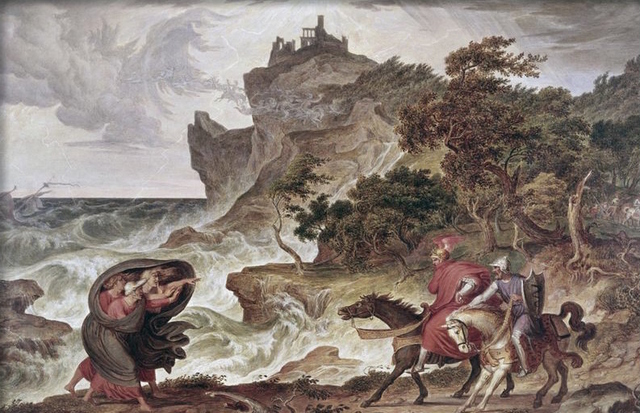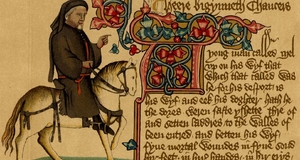Anti-Semitism and Religious Intolerance in Aristocratic Age English Literature
By
2015, Vol. 7 No. 03 | pg. 1/3 | »
KEYWORDS:
Anti-semitism was a prevailing cultural sentiment in Europe, particularly in Great Britain, during the period when some of English literature's most celebrated figures, including Marlowe, Shakespeare, Donne, and Chaucer, penned their famous works. Within these works, anti-semitic themes are clearly apparent. While they reflect the cultural sentiment of the era, they also provide a valuable commentary on the social views and beliefs of the sixteenth century. In Shakespeare's Macbeth, the witches’ scene intimates an anti-Semitic theme by comparing Jews to filthy, grotesque objects, while in The Merchant of Venice, Shylock’s portrayal serves as a means through which anti-Semitic themes are also conveyed. Similarly, in The Jew of Malta, by Christopher Marlowe, an anti-Semitic theme is implied through the character Barabas the Jew. Finally, John Donne’s Holy Sonnet XII and Geoffrey Chaucer’s The Canterbury Tales impart decidedly anti-Semitic themes while alluding to the crucifixion of Jesus. These referenced literary works poignantly demonstrate and help reinforce Great Britain’s historical antipathy towards Jews, while concomitantly serving to validate or challenge societal views during the aristocratic age. One of William Shakespeare's latest and greatest plays, Macbeth, contains an unmistakably anti-Semitic reference that serves to reinforce contemporary gruesome witchy stereotypes. Specifically, in preparation for a visit by Macbeth, the three witches, while stirring their cauldron for “a charm of powerful trouble” (Shakespeare 121; 4.1.18), chant their incantations and enumerate their potion’s ingredients, which include “Liver of blaspheming jew” (Shakespeare 121; 4.1.26). In and of itself, this statement unambiguously disparages Jews as being blasphemous, arguably the worst profanity that one could possibly levy upon another human being during that era. In so doing, Shakespeare mirrors contemporary anti-Semitic attitudes. By swearing against a Jew, Shakespeare’s writing evokes a bigoted, snarky tone that is highly suggestive of the ubiquitous prejudice against Jews that erupted during the Inquisition and Protestant Reformation eras. Moreover, lumped together in the witches' diabolical brew are many universally reviled and disgusting objects, such as “eye of newt and toe of frog” (Shakespeare 121; 4.1.13), the toxic “root of hemlock,” (Shakespeare 121; 4.1.25), and, a “finger of birth-strangled babe” (Shakespeare 121; 4.1.30). These aforementioned flagrant, unsavory associations only further connote the glaringly pervasive anti-Semitic theme that was endemic in England during the Jacobean era, when Macbeth was published. It is also quite telling that the ingredient taken from the Jew just happens to be the liver, the seat of the bilious humour known as Choleric, which is classically associated with particularly undesirable personality traits: being easily angered and bad tempered. By deliberately associating liver and Jew and thereby making a correlation with these intrinsically offensive humoural characteristics, an intentionally negative connotation is suggested, thus indirectly further implying an anti-Semitic theme. This anti-Semitic reference, “Liver of blaspheming jew” (Shakespeare 121; 4.1.26), is skillfully woven into the work in order to poignantly enhance the gruesomeness of the witches’ potion. In so doing, Shakespeare mutually reinforces common negative stereotypes for both witches and Jews that existed during his lifetime. When this play was published, in 1606 – during the early reign of James I – the few Jews that did manage to survive the Inquisition and Reformation and live in England were viewed as grotesque heretics who made pacts with the devil. In English society, Jews were sometimes branded as scapegoats disasters, including the Bubonic Plague. Considering this historical context, one can infer that this theme of religious intolerance in Shakespeare’s works represents the social milieu that existed during Shakespeare's literary career in the Elizabethan and Jacobean eras. The Jew of Malta, written during the Elizabethan era by Christopher Marlowe, unabashedly resonates with anti-Semitic themes, particularly through the character of Barabas the Jewish merchant. With his very name a stinging cultural prejudice is unambiguously connoted: Barabbas is the biblical name of a notoriousJewish man—both a thief and murderer—who, by public acclaim, was pardoned from crucifixion and released from Roman custody during a Passover feast in Jerusalem. Subsequently, Jesus of Nazareth was crucified in his stead.In that zero sum game, Barabbas escaped execution as his life was tragically paid for with Jesus' death.Therefore,according to the Gospel, both Barabbas, a Jew, and the crowd of Jews that chose to save him, indirectly catalyzed the death of Jesus. As a result of this event, known as Jewish deicide, Jews were historically blamed for the crucifixion and death of Jesus, thus forming the basis and justification for Christian anti-Semitism. Accordingly, by deliberately selecting the name Barabas the Jew, Marlowe alludes to the popular belief at the time that Jews were the sinful and wicked murderers of Christ, thereby unmistakably suggesting an anti-Semitic theme. Moreover, Barabas further inspires antipathy for Jews by virtue of the unflattering way in which he is characterized by Marlowe. A poignantly anti-Semitic theme is intimated from the very outset of the play, when Barabas is first depicted with stereotypical greed, sitting in a counting house with heaps of gold coins sprawled out before him (Marlowe 334; 1.1). This scene, with its powerful visual imagery, promotes a negative portrayal of Barabas, who appears to be a miserly figure as he counts all of his hoarded money. As Barabas is primarily preoccupied with amassing “infinite riches in a little room” (Marlowe 334; 1.1.37), he seems to be decidedly guided by pecuniary concerns, with an internal compass that firmly points in the direction of wealth and self-interest, further reinforcing anti-Semitic prejudices. Barabas serves as the vehicle through which Elizabethan society’s cultural prejudices can be personified. These religious prejudices, exemplified in Shakespeare’s writing, reflect a deep-rooted intolerant climate encompassing the sixteenth century, a period during which Jews lived in small number in England as Marranos, Jews pretending to be Catholic, and Conversos, converted Jews, due to rampant anti-Semitic backlash. Ultimately, this religious intolerance toward Jews is manifested through Christopher Marlowe’s portrayal of Barabas in order to validate a contemporary anti-Semitic stereotype. Barabas is also described as being selfish, particularly when three fellow Jews approach him seeking advice concerning “a fleet of warlike galleys” (Marlowe 337; 1.1.144). Upon counseling these men, Barabas asserts that should the Turkish fleet invade Malta, “let 'em combat, conquer, and kill all/So they spare me, my daughter, and my wealth” (Marlowe 337; 1.1.150-151). As revealed by this passage, Barabas can be viewed as an egocentric man who is solely concerned with himself and his daughter, Abigail, to the complete exclusion of all of his landsmen. This selfish portrayal illustrates his greedy, conniving nature, wholly consistent with prevailing anti-Semitic attitudes of those times. Moreover, this anti-Semitic theme, by virtue of Barabas’ negative depiction, seems to validate the contemporary disparaging view of Jews by proffering a despicable, penny-pinching Jewish stereotype. Furthermore, the description of Barabas as a selfish, greedy rogue unabashedly connotes an anti-Semitic theme as these unsavory traits not only help define him, but can also be equated to his Jewishness, which Marlowe painstakingly made central to this character's identity. He is consistently referred to and addressed by the name “Jew” by Maltese officers, Ferneze, Calymath, son to the Emperor of Turkey, and even himself. For instance, Ferneze calls Barabas a “base Jew” (Marlowe 390; 5.5.74). Even in the prologue, Machiavelli refers to the play as the “tragedy of a jew” (Marlowe 333; Prologue, 30) rather than the “tragedy of Barabas,” which would suggest that his identity is exclusively derived from his being Jewish. Moreover, the blatantly gratuitous and disturbing use of the word "Jew" in the play's title only further buttresses the notion of a pervasive anti-Semitic theme that comfortably mirrored contemporary cultural prejudices, without any fear of reprisal. As perennial outsiders, Jews were easy targets for vilification and were commonly viewed with contempt:in addition to being blamed for killing Jesus, they were also accused of kidnapping children, circumcising them, and then, like vampires, drinking their blood. Whenever invoked in those times, the appellation "Jew" was never proffered as a compliment; rather, it was always intended as a slur, reflecting prevalent anti-Semitic sentiment. Accordingly, as condoned by contemporary audiences, an anti-Semitic theme is suggested by virtue of Marlowe's wanton and derogatory use of the word "Jew." Marlowe further engenders anti-Semitic sentiment by depicting Barabas as prejudiced towards Christians when he attacks Ferneze and challenges the Christian view that all Jews should be punished for other Jews’ sins. In an attempt to evade taxes, Barabas presents an argument to Ferneze, pointing out the inequity of the law and, in so doing, inadvertently reveals his own anti-Christian feelings. Barabas declares to Ferneze, “‘Some Jews are wicked, as all Christians are’” (Marlowe 341; 1.2.113-116). This statement reveals his bigotry, which casts him, and, by association, all Jews, in a negative light. This unsavory depiction connotes an anti-Semitic theme wherein the image of the Jew, inextricably intertwined with that of Barabas, is indirectly being sullied; this negative perception permeated the Aristocratic Age. When Marlowe indirectly characterizes Barabas as a monstrous villain, he further implies an anti-Semitic theme due to the inherent association between Barabas and his Jewishness. Barabas is represented as a murderous scoundrel who directly and indirectly facilitates the demise of multiple characters. For example, he catalyzes the murder of Don Lodowick, Ferneze’s son, and Don Mathias, Abigail’s lover, as these men fight to the death over the hand of his daughter, Abigail (Marlowe 362; 2.3). In addition, upon learning that his daughter, Abigail, has absconded to become a nun, Barabas heinously plans to poison her and the nunnery. As Barabas declares to Ithamore, a Turkish slave, “‘Ne'er shall she live to inherit aught of mine,/Be blest of me, nor come within my gates,/But perish underneath my bitter curse’” (Marlowe 365; 3.4.29-32). Such actions reveal his heartless, violent nature, as he deliberately plots the demise of numerous innocents – including his own kindred, the one person for whom, beside himself, Barabas expresses concern. Accordingly, his unfavorable portrayal, through its association with hisJewish identity, conveys an anti-Semitic theme, which reflects the religious intolerance that plagued much of Europe during the Protestant Reformation, when Jews were forced to convert to Christianity. An anti-Jewish sentiment is further revealed when Barabas laments that he is hated for being a rich Jew: “‘Who hateth me but for my happiness?/Or who is honour’d now but for his wealth?/Rather had I, a Jew, be hated thus,/Than pitied in a Christian poverty’” (Marlowe 336;1.1.110-113). While similarly wealthy Christians face no prejudice, Jews such as Barabas endure a deep-rooted hatred and resentment; this discrepancy illustrates a pervasive cultural prejudice towards Jews, a continuously persecuted minority during those times. In addition, other characters in the play express anti-Semitic sentiments, particularly Ferneze, governor of Malta: he exclusively taxes the Jews in order to secure the revenue needed to pay Turkish tribute. Ferneze avers that he will, under no circumstances, treat the Jews equally under the law in matters concerning taxes by stating, “No, Jew, like infidels;/For through our sufferance of your hateful lives/Who stand accursed in the sight of heaven/These taxes and afflictions are befall'n” (Marlowe 340; 1.2.63-66).The governor adopts a harsh, prejudiced tone through his use of hateful diction, relegating Jews to the status of infidels and essentially labeling them the bane of Christians’ existence. Likewise, religious intolerance towards Jews is demonstrated when Ferneze agrees to exempt Barabas from paying taxes for Turkish tribute only if the latter accedes to convert to Christianity: Ferneze: ‘Why, Barabas, wilt thou be christened?’ Since Ferneze proclaims conversion from Judaism to Christianity as the only means of securing tax immunity, Barabas’ Jewishness is invariably connoted as a negative attribute. Accordingly, one can construe a thoroughly anti-Semitic streak in Ferneze’s words. More anti-Jewish sentiment permeates the text, as Barabas, in addition to every Jew in Malta, are forced to relinquish half of their property, according to the articles declared by Ferneze’s officer. The officer avows, “‘First, the tribute money of the Turks shal all be levied amongst the Jews, and each of them to pay one half of his estate’” (Marlowe 340; 1.2.68-70). Barabas’ Jewish identity is implied as an inherent flaw for which the price of taxation must be paid. Thus, Jews are intrinsically viewed with contempt. Finally, this anti-Semitic tone is further connoted in the speech of Ferneze’s First Knight, who directly points out Barabas’ “inherent sin” (Marlowe 341; 1.2.110) – his being a Jew – as a means of justification for cheating Barabas out of his wealth. This is blatant discrimination against Jews. This blanket, indiscriminate prejudice against an entire race of people without any consideration of individual merits is discrimination at its worst: this reflexive hatred relentlessly plagued Jews throughout Europe and very well could have been the seed that ultimately germinated into the genocide that was the Holocaust.Continued on Next Page » Suggested Reading from Inquiries Journal
Inquiries Journal provides undergraduate and graduate students around the world a platform for the wide dissemination of academic work over a range of core disciplines. Representing the work of students from hundreds of institutions around the globe, Inquiries Journal's large database of academic articles is completely free. Learn more | Blog | Submit Latest in Literature |

















